HANDICRAFTS FROM OAXACA
Handicrafts from OAXACA
Oaxaca’s handicrafts are a tradition and offer a diversity that denotes the artistic richness and imagination of its people. The talented artisans of Oaxaca make beautiful pieces of clay, textiles, wood, metal, skins and other materials, forming a rich and varied folk art in both decorative and useful items.
The handicrafts in Oaxaca are so varied and of such good quality that they have become a tourist attraction. The ancestral traditions, the diversity in the ethnic groups, as well as the richness in the history of the state have been able to manifest in the great diversity of creations of more than half a million artisans that are registered in Oaxaca.
Each of the products made has its own characteristics, making it unique. The variety is one of the most extensive in the country and covers all branches: saddlery, tinsmithing, ceramics, stonework, jewelry, textiles, wool rugs, pottery in all its branches, saddlery….
Oaxaca Handicraft Market
The Oaxaca Craft Market was inaugurated in 1980. It is one of the most colorful and assorted in Mexico, becoming a national and international reference in this type of establishment. It is on the corner of Ignacio Zaragoza and JP García streets, in the center of the city. It has 30 stores where the best of Oaxacan folk art is displayed, including alebrijes, textiles, pottery, embroidery, and rugs.
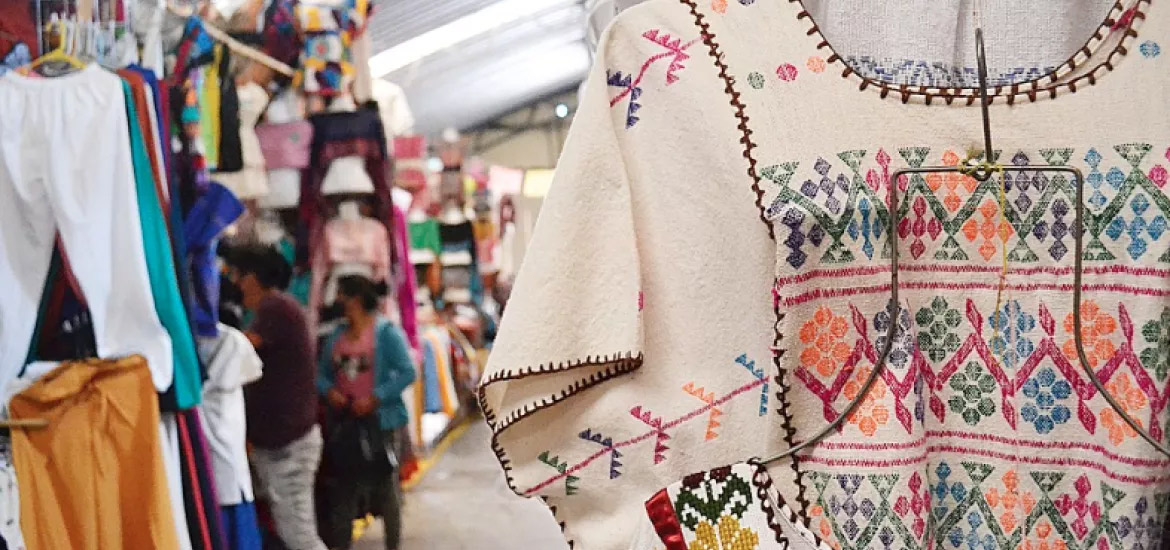
Alebrijes
The alebrijes are among the most captivating Mexican crafts and among the most valued for their originality and extravagance. These colorful animal figurines with fantastic features can be found in craft markets, street stalls and art galleries alike. Despite their popularity, the alebrijes are not as old as many would believe, in fact, their origin is quite peculiar and here I will tell you a little about it.
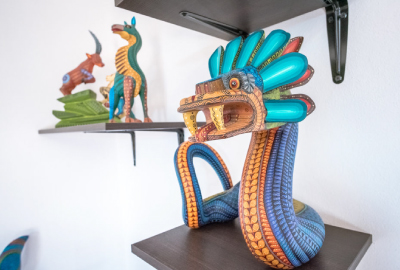
We owe the invention of the alebrijes to Pedro Linares, an expert craftsman in cartonería from Mexico City. The origin of his work is not a fortuitous thing, but the result of one of the hardest episodes in his life. As unfortunately happens with many Mexican artisans, Don Pedro found it hard to support himself financially with his trade.
At the age of 30 (around 1936) he contracted a disease that kept him prostrate and on the verge of death, Don Pedro sank into a deep sleep, during his unconsciousness, he had the sensation of having been in a quiet forest crossed by paths rocky areas where I frequently heard strange noises. When looking for the origin of those sounds, extraordinary creatures appeared in front of him that incessantly repeated the same word: alebrije. It was at this moment that luck turned around. Health returned to the artisan’s body, also bringing the idea that would make him famous in Mexico and the world.
The alebrijes quickly became popular, and in many corners of Mexico, artisans continued to reproduce the legacy of Pedro Linares. But it is in Oaxaca where this craft has reached its maximum splendor. They are traditionally made in San Antonio Arrazola and San Martín Tilcajete. The various shapes of the copal branches invite artisans to let their imagination run wild and, with the help of machetes and knives, give life to these fantastic figures that combine characteristics of different animals to form creatures that are as monstrous as they are fascinating.
An alebrije has behind it a long job of carving and painting. Depending on the complexity of the design and finish, a piece can take months or even more than a year to complete.
Leather and fur crafts from the Jalatlaco neighborhood
The Jalatlaco neighborhood of Oaxaca City was already an indigenous community when the Spanish arrived. In the 1520s, the conquistador, Francisco de Orozco, settled Nahua and Mexica Indian allies in the place, who learned the trade of saddlery, the embryo of the current leather craft work in the neighborhood and the city. Located 20 blocks northeast of the Zócalo of the Oaxacan capital, Jalatlaco is one of the main centers for the production of leather and fur handicrafts in the state.
Pieces manufactured in smooth or embossed finishes, with a range that includes jackets, vests, bags, wallets, shoes, belts, boots, huaraches, caps, hats, stationery and horsemanship items. Jalatlaco also became the neighborhood for tanners in Oaxaca, bringing together the largest number of tanneries, an activity that has almost disappeared in the area.
Black Clay from San Bartolo Coyotepec
Oaxaca is the only place in the world where black clay is worked, so a pot or vase made of this material is, without a doubt, one of the pieces of Oaxacan crafts that you cannot miss.
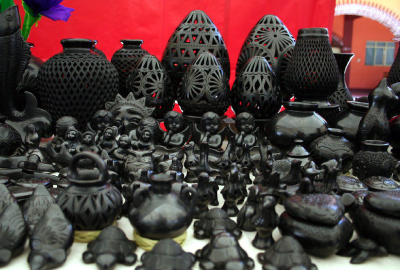
San Bartolo Coyotepec is famous for the elaboration of various black clay products. Talking about black clay means talking about Mrs. Rosa Real Mateo de Nieto, an artisan from San Bartolo Coyotepec who, in the mid-20th century, discovered the method for making matt gray clay pottery pieces to gain an attractive glossy black. If these were fired at a slightly lower temperature and polished before fully drying, they would emerge a radiant dark colour.
This discovery defined one of the main lines of work in Mexican ceramics, with highly appreciated pieces for decorative purposes, since they are more fragile and have no practical use in the kitchen or at home. The pieces are polished with curved quartz stones and manipulated with sharp objects to create unique designs, which make them highly valuable crafts.
San Bartolo Coyotepec is a town in the Central Valleys where Doña Rosa’s workshop is still in force, now run by her descendants and 60 other family businesses dedicated to black clay pottery.
Matte Gray Clay from San Bartolo Coyotepec
Although the main occupation of the potters of San Bartolo Coyotepec is polished black clay, they have not stopped making pieces of matte gray clay, especially the pitchers used in Oaxaca to ferment and store the famous local mezcals in the distilleries.
Matte gray ceramic is manufactured in a similar way to glossy black, with the exception that in the former the pieces are fired at a higher temperature and dried completely.
In both cases, the clay is the same and the ceramics are fired in wood-fired ovens or in holes underground. Due to their resistance, the vessels, jugs, plates and other items made of matte gray clay do have the daily uses for which they are intended, unlike the shiny black clay which is basically decorative.
San Bartolo Coyotepec is located 17 km south of the city of Oaxaca and is home to the State Museum of Popular Art of Oaxaca, which exhibits Oaxacan handicrafts with particular emphasis on ceramics that symbolize the town.
Green Clay from Santa María Atzompa
The pottery of Santa María Atzompa, a community near the city of Oaxaca, is very famous for its green glazed slab. This is characterized by its designs made with the pastillage and fretwork technique. They mainly make pots, flower pots, pitchers, vases, casseroles, jugs, chirmoleras, crockery, toys and countless decorative items. The clay is fired only once and then bathed in green clay, a material that is sold already prepared in the city of Oaxaca, thus creating the green glazed pottery.
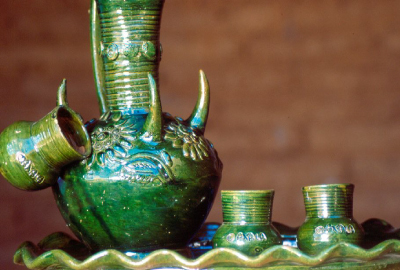
If the shiny black clay is the iconic craft of San Bartolo Coyotepec, the glazed green clay is from Santa María Atzompa, a town in the Central Valleys of Oaxaca 7 km northwest of the state capital. The glassy green clay reaches its characteristic coloration after a second firing of the pieces, to which a clay has been applied.
The technique was taught to the indigenous people of Oaxaca in the 16th century by the Spanish missionary, Alonso Figueroa. It consists of diluting a powdered clay in water that is then applied externally to the pieces before being subjected to a second firing. After going through the kiln for the first time, the items gain the whitish color that the clay gives them.
Artisans transport the clay tiles on donkey backs from their source in the nearby San Lorenzo Cacautepec mines. In the collapse (by beating sticks) the whole family participates. Then the clay is turned into pieces in the ancient foot lathes.
Red Clay from San Marcos Tlapazola
Having all the crockery and red clay crockery gives an impressive and original touch. You can find these pieces in San Marcos Tlapazola, 35 km southeast of Oaxaca de Juárez, very close to Tlacolula de Matamoros, in the Central Valleys Region. Ceramic work in this town has been adapted to obtain different shades of red and the pieces are sold locally and in the cities of Tlacolula and Oaxaca.
Pots, saucepans, pichanchas, comales, beaters, pans, vessels, plates, platters, sauce boats and teapots, are part of the list of items with which you can beautify your kitchen with red artisan pieces. During the Guelaguetza celebration (two Mondays after July 16, the day of the Virgen del Carmen) the Red Clay Fair is held in the center of San Marcos Tlapazola, an excellent opportunity to see a wide variety of ceramics and buy good prices.
Oaxacan Cutlery
In Oaxaca there is an ancient tradition of forging knives, swords, machetes, cutlery and other sharp metal objects for household use, especially in the towns of Tlaxiaco and Ocotlán and in the city of Oaxaca.
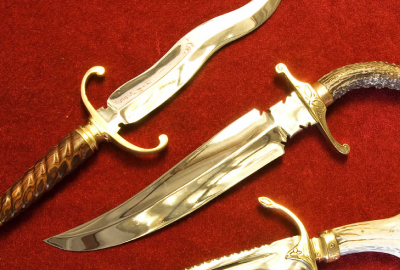
The artisans who make these beautiful pieces are part of a true Oaxacan lineage, a lineage of knife makers that goes back to the colonial period when the conquistadors brought their advanced manufacturing methods to America and when the demand for bladed weapons and sharp objects was high.
One of the great figures in the art of Oaxacan cutlery is Don Guillermo Aragón Guzmán, a member of the sixth generation of a family of knife makers installed in Oaxaca de Juárez in the mid-18th century. The Aragón family began manufacturing machetes for the peasants who worked in coffee plantations, sugarcane fields and other plantations.
Currently the workshop also forges katanas and samurai sabers, to meet the growing interest in oriental martial arts.
The pieces are worth their price for the processing time. For example, a flatware set for 6 people (48 pieces) takes 40 days for a full-time craftsman.
Handmade Cosmetics
Oaxaca has a coastline of 568 km in the Pacific Ocean where there are fantastic beaches such as Puerto Escondido, Huatulco, Zicatela, Zipolite, Mazunte and Carrizalillo. The sea and the waves are shaping millions of shells used to make necklaces, bracelets and other ornaments.
On the coast and in the estuaries of the rivers that drain into the ocean grow coconut palms and natural fiber plants, which Oaxacan artists use to make beautiful handicrafts and produce natural products. One of the crafts of the Oaxaca coast developed from coconut is that of natural cosmetics.
Coconut is a main ingredient to manufacture handmade and natural beauty products, due to its moisturizing and firming properties in the treatment of skin and hair. These handmade cosmetics are found in Mazunte and other towns on the Oaxacan coast, made by artisans who know the value of an organic product.
Gold and Silver Filigree
The art of filigree is delicate and laborious, especially if threads and drops of gold, silver and other metals are part of complex designs. Mexican goldsmiths have known about it since pre-Columbian times and the work of Mixtec artists reached a notable development, as evidenced by archaeological finds in Oaxaca sites.
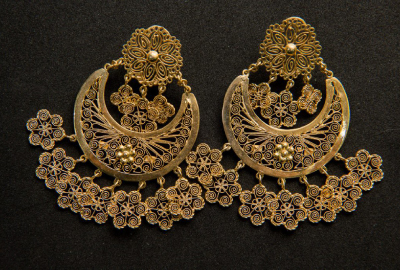
Currently, the main Oaxacan creators of filigrees are in the Sierra de Juárez, the Isthmus of Tehuantepec and Oaxaca de Juárez. The earrings and other gold filigree jewelry are part of the typical gala clothing of the Oaxacan woman, including the precious Tehuana costume, an artisan symbol of the state in Mexico and the world.
Much of the filigree work of pre-Hispanic Mexican goldsmiths was destroyed during the Conquest and in the viceregal period by smelting to have precious metals for other purposes. However, jewels such as the pectorals of the God of Death and the God of the Sun, found in Tomb 7 of Monte Albán (Oaxaca), show the advanced art of filigree in pre-Hispanic Mexico.
Goldsmith
The discovery of Tomb 7 of Monte Albán, in 1932, exposed the largest deposit of gold works in Mesoamerica, rediscovering the working techniques of the Mixtec culture. Throughout the last 90 years, a style of goldsmithing based on the Mesoamerican tradition in metalworking has taken shape in the state of Oaxaca, especially in the city of Oaxaca de Juárez.
Reproductions of Monte Albán jewels such as pectorals, rings and bracelets with fine finishes, constitute one of the most original and valuable craft fields in the region. Gold and silver jewelry was for public use in Oaxaca and other Mexican cities until well into the 20th century, not only by people of high economic position, but also by humble people who kept some objects to use as part of their clothing.
This custom has been lost for security reasons, but Oaxacan goldsmithing has maintained its momentum with pieces to collect and treasure.
Lead Miniatures from Tlaxiaco
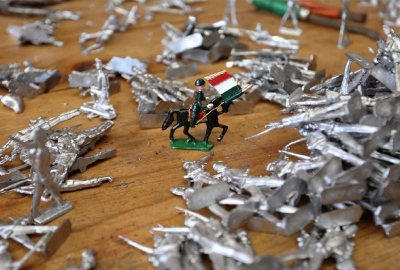
One of the most unique typical crafts from Oaxaca are the lead miniatures made by the creators of Tlaxiaco, who turn molten metal into soldiers, characters from the pre-Hispanic era, figures of Independence and the wars of the 19th and 20th centuries, images with the typical clothing of Oaxaca and other motifs.
This handmade line also includes delicate Christmas nativity scenes, clowns and other representations. Miniatures have been part of Mexican culture since pre-Columbian times, when newborn Indians received small-scale gifts of the main objects related to their future work.
Artisan Mezcal
Mezcales are one of the handicrafts from Oaxaca with a great reputation in Mexico, this being one of the Mexican states with the longest mezcal tradition, with products that enjoy denomination of origin to protect them from unfair competition. Many mezcaleras in Oaxaca continue to make mezcal the old-fashioned way: grinding the agave piñas with animal traction and using the old procedures in cooking and other phases of making the drink.
These artisan mezcals have the charm of the old days and are a symbol of Oaxaca. Many of them, are manufactured in Santiago Matatlán, a town in the Central Valleys. It is ground in a tahona, cooked in conical earthen ovens and fermented in wooden vats with a double distillation in copper stills. It is soft, smoky and with fruity and cooked agave notes.
Tin Crafts from Tehuantepec
In the Isthmus of Tehuantepec, a line of artisan work began almost a century ago that consists of the elaboration of tin items, such as marmots, candelabras, and reliquaries, especially for regional Catholic temples and for very devout families.
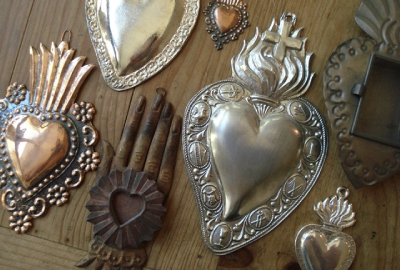
The works used to carry motifs inspired by nature such as animals, flowers and plants, as well as representations related to special events such as baptisms and weddings.
The tinsmith was also in charge of manufacturing kitchen utensils and articles for domestic use in bathrooms and showers. The tradition of tinsmithing has been maintained and tin hearts, also known as “miracles”, have become an iconic product of this type of craft.
In the December season, the Noche Buena flowers are typical. Apart from tinplate, craftsmen use brass, copper and leather as frequently used materials. The main tools are steel knives, chisels, and welding equipment.
Reed basketry from Cuilápam de Guerrero
Cuilápam de Guerrero is a town in the Central Valleys of Oaxaca, 13 km south of the state capital. Its artisans skillfully work the reed with which they make beautiful baskets of different sizes and models, lamps and other pieces. The reed is a species of reed that grows in wetlands and on the banks of lagoons and rivers, which can reach 4 meters high and 2 cm in diameter in its woody stems. It has been used since pre-Hispanic times for basketry, roofing of huts and fences.
Other products made by Cuilápam artisans are zompantle or colorín tree masks, headdresses of various sizes, and embroidered blouses. In the town, they make mezcal the old-fashioned way and salt from maguey worms and chile de árbol, one of the most exotic artisan condiments in Mexico made with a pre-Hispanic and 100% Oaxacan recipe.
Wooden Masks of Santa María Huazolotitlán
Wooden masks are famous in Santa María Huazolotitlán. Animals are the most common theme for the elaboration of these handicrafts that the inhabitants of the region use for their traditional festivals.
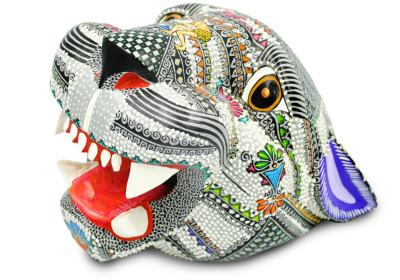
Pumas, tigers, lions, panthers and bulls are the main motifs of the artisans of this typical Oaxacan folk art that consists of making wooden masks. They also offer rabbit and deer masks, from which the indigenous population derived and derives part of their livelihood.
The masks with human faces also have their space, some with typical Mexican ingenuous faces and others fierce and intimidating. These masks, authentic jewels among Oaxacan handicrafts, are used by the population in their traditional festivals. The town in Oaxaca most committed to its preparation is Santa María Huazolotitlán, in the Coastal Region.
The popular culture of Santa María Huazolotitlán is rich in dances manifested on festive occasions, especially Carnival and in the patron saint festivities in honor of the Virgen de la Asunción. Among these choreographies, which include beautiful costumes and masks, are the dances of the little masks, the badgers, the turtle and the plumudos.
Huaraches
One of the Oaxacan handicrafts that best represents popular creation is the making of footwear and clothing, such as Huaraches. This type of craft is very common throughout the state since it is a shoe widely used by people from different Oaxacan communities.
The municipalities, cities and towns scattered throughout the 8 regions have specialized in various garments in a Oaxacan municipality in the Sierra Region, Villa Hidalgo, which is distinguished by handcrafting for the manufacture of footwear so popular in Oaxaca and Mexico. The artisans of the town make and wear beautiful leather sandals with figures of flowers and animals, made with velvet and other materials.
In some places they are made of leather straps and mouthpieces; in others, such as Coixtlahuaca, they are made from palm. Some of the most beautiful huaraches are those used by women in Yalalag, in which the roughness of the leather contrasts with the velvet in which different figures of animals and flowers are depicted.
Palm crafts are also characteristic of the Mixteca region. Among the most common items are: hats, tents, blowers, soyates, petates, vases and purses.
TEXTILES FROM OAXACA
An item that Oaxacan popular creators work with particular skill and beauty is the textile crafts that they produce in a wide variety of pieces of fine clothing and cheerful colors. The textiles that identify the city of Oaxaca are, especially, table linen products, characteristic for their unique designs of pre-Hispanic and colonial reminiscence. They are traditionally made on a pedal loom and shuttles, with cotton thread, natural in color and dyed with natural and artificial dyes.
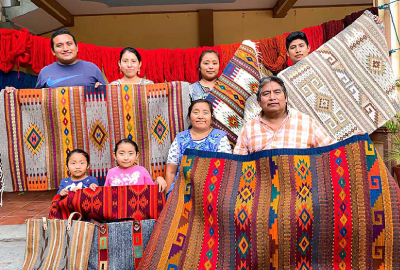
The most widely produced items are: tablecloths, napkins, rugs, curtains, bedspreads, covers and towels. All of them designed to fulfill their utilitarian function and to look like true decorative pieces. In addition to these products, there is a wide variety of textile crafts from towns near the city, and from other regions of the state.
All unmistakable for their highly original designs and colors that identify each region. From Teotitlán del Valle, Mitla and Tlacolula, come the blankets, jorongos, rugs and rugs, made on a pedal loom, with wool thread, natural and dyed with natural dyes. Their designs range from Zapotec codices and characters to pictorial reproductions of Tamayo, Toledo and Picasso.
From Mitla and Santo Tomás Jalieza there are: shawls, dresses, huipiles, blouses, overcoats, shawls, bags, sashes, rugs, napkins and tablecloths, made with cotton thread, wool and worsted. From San Antonino Castillo Velasco, dresses and blouses embroidered with silk thread.
The famous regional costumes, of pre-Hispanic origin, which include: huipiles, tangles and quexquémitls, unmatched for their colorful designs, characteristic for their elaboration on a waist loom, based on silk and velvet fabrics with fine embroidery.
Leather and palm huaraches, blouses embroidered with silk threads, dresses, shawls, sashes, jorongos, blankets, rugs, rugs, shawls, bags, cloth napkins, and tablecloths, are also some of the textile items magnificently made by artisans from Oaxaca.
Embroidery of San Antonino Castillo Velasco
In the town of San Antonino Castillo Velasco, head of the municipality of the same name in the Central Valleys, 35 km south of Oaxaca de Juárez, an association of women embroiderers called, Hazme si Puedes, is dedicated to rescuing the ancient embroidery techniques in the region.
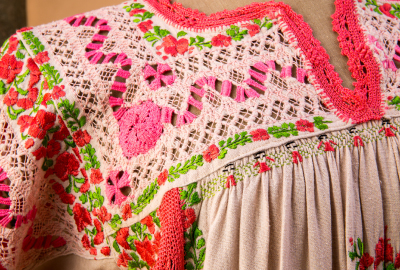
18 embroidery techniques are known, of which 5 are currently being used, including the so-called, “Hazme si puedes (Do me if you can)”, which literally describes their degree of difficulty.
The artisans of San Antonino learned to embroider through family inheritance and they embody their designs in huipiles, blouses, dresses and other clothing and accessories.
Some pieces that serve as models are more than 100 years old. San Antonino is a cozy town at 1,500 meters above sea level.
Textiles from the Xochimilco neighborhood
Xochimilco is another of the historic neighborhoods of Oaxaca de Juárez with origins in pre-Hispanic Mexico. It was founded in 1486 by Ahuízotl, a Mexica tlatoani huey, whose soldiers cut down a gourd forest that was on Cerro del Fortín, the highest point and geographical symbol of Oaxaca, to build the place.
It is a neighborhood with an old vocation for crafts, especially in the fields of textiles and tin items. Xochimilco artisans make tablecloths, napkins, bedspreads, covers, curtains, and towels on pedal looms and shuttles. The main material is cotton and the works have a clear viceregal influence.
Some 35 artisan workshops in Xochimilco exhibit and sell their crafts at the Oaxacan Institute of Handicrafts, in the Mercado de Artesanías, in the Mercado Benito Juárez, in galleries, and in shops in the city.
Woolen Sarapes from Teotitlán del Valle
The jorongo or sarape is a garment worn by Mexicans and some southern Americans to protect themselves from the cold or rain. It is similar to the Andean poncho and serves as a blanket and rug. In Teotitlán del Valle, artisans are dedicated to the creation of intricate and exquisite wool rugs.
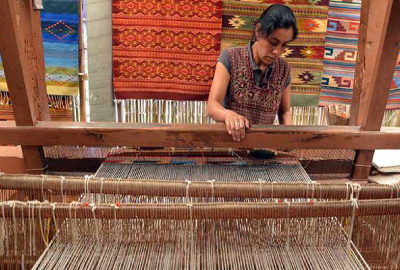
The wool sarape made in Teotitlán del Valle is famous among the handicrafts of Oaxaca, a town 28 km southeast of Oaxaca de Juárez towards the Isthmus of Tehúantepec, which is also distinguished by its coats, rugs, bags, rugs and curtains.
The handmade pieces of Teotitlán del Valle are dyed naturally with the parts of some plant and animal species. The main dye used comes from the grana cochineal or carmine cochineal, an insect that parasitizes nopal plants, giving it a crimson red color. Other sources are pomegranate peel (yellow), walnut shell (coffee brown), and indigo (blue).
Tour the workshops and discover the process of spinning a rug, from the earliest stages to the latest. The Teotitlán rugs are one more reason to visit Oaxaca.
Santa Ana del Valle Rugs
Mexico has a long tradition of weaving rugs and rugs made from natural fibers and commercial yarns in clever designs and bright colors. In Oaxaca there are several towns dedicated to the artisan production of these pieces, highlighting Santa Ana del Valle, a town in the Central Valleys 34 km southeast of the state capital.
The town is known for making wool rugs and rugs. The pieces are woven by hand with carded threads on pedal looms. The dyes used are of natural origin. Various wool textiles are made in the town, including jorongos, overcoats, backpacks and other items with which the artisans show their skill and ingenuity as weavers.
In Santa Ana del Valle you can visit the workshops where the beautiful pieces are made and sold, as well as its 18th century church and a small archaeological museum.
Huipiles from San Felipe Jalapa de Díaz
“Ornate blouse or dress” is the meaning in Spanish of the Nahua word “huipilli”, which identifies this colorful and embroidered piece of clothing that is used especially in southern Mexico.
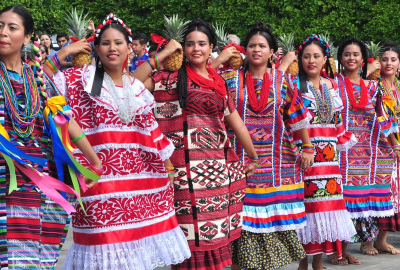
The Mexican states with the longest tradition in making huipiles are Oaxaca and Yucatán, where the garment is used by women as daily clothing. San Felipe Jalapa de Díaz, a small city in Oaxaca, in the Cuenca del Papaloapan or Tuxtepec Region, stands out for the manufacture of these pieces.
The garment is heavily involved in local clothing, being made with different materials (fabric and lace for frequent and gala use) and for various occasions.
The gala huipiles are embroidered with threads of various colors representing motifs such as flowers, animals, leaves and other elements related to the flora, fauna and culture of the region.
The main local dances such as Flor de Piña, the Huipilito de Jalapeña and the Danza de las Pastoras have the huipil in their costumes.
Pozahuancos
The pozahuanco or tangle is a typical female garment that survives in towns in Oaxaca between tradition and disuse. It is an artisan piece made on a waist loom or by hand and dyed with natural dyes of indigo blue, cochineal scarlet and purple snail, among other colors.
Garments are worn to wrap around the hip. They are made in beautiful designs that have complicating elements depending on the communities they come from. They are fastened at the waist with girdles or girdles and the materials used vary from one place to another, cotton being one of the most used.
A tradition in danger of disappearing is the inclusion of an elegant pozahuanco in the wedding dress donated by the in-laws to the future wife of a male child. It can also be dressed as a kind of skirt. On the Costa Chica and other areas of Oaxaca, the pozahuanco subsists as a symbol of identity, thanks to the women who weave and dress it.
Rebozos from Oaxaca
In the city of Oaxaca and other towns in the state, it is typical to see indigenous women carrying their babies and small children in shawls, a wide and rectangular piece of clothing that provides a comfortable and practical means of transporting the children.
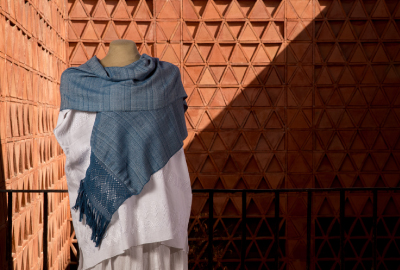
The rebozos can be up to 3 meters long and 1.5 meters wide and are used as shawls and scarves. They are made of wool, cotton, silk and other materials, so they have a wide range of prices.
Several towns in Oaxaca stand out for making shawls and other textile pieces, including Santo Tomás Jalieza and Villa de Mitla. The first of these towns is a town in the south of the Central Valleys, 29 km from Oaxaca de Juárez.
It also stands out for the craftsmanship of leather, especially belts. San Pablo Villa de Mitla is another town in the valleys known for its important Zapotec archaeological site.
Tablecloths from Oaxaca
The Pueblo Nuevo sector of the city of Oaxaca has become the main center for making artisan tablecloths in the state, bringing together more than 20 workshops that make cotton pieces on the traditional chicote pedal loom.
The chicote pedal loom is for limited production (approximately 5 meters of cotton fabric per hour), which allows making custom-made pieces with original artistic designs in each unit.
The tablecloths are made in colorful designs that add a cheerful and colorful note to mealtimes. Teotitlán del Valle is a famous town for making its well-known wool sarapes and other items such as overcoats, bags, rugs, and rugs.
Typical Costumes of OAXACA
Typical Tehuana costume
The Isthmus of Tehuantepec is one of the 8 Oaxacan political regions and a geographical space that hosts in Oaxaca and Veracruz the shortest distance (200 km) in Mexican territory between the Pacific and Atlantic Oceans.
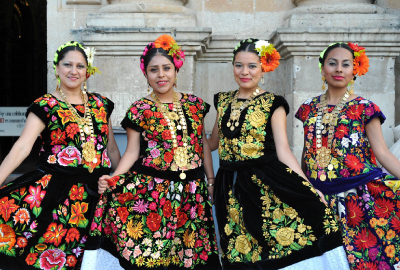
One of the most beautiful crafts in Mexico is the Tehuana suit, originally from the Oaxacan municipality of Santo Domingo de Tehuantepec. It is the typical dress of the Zapotec women in their daily activities, celebrations and ceremonies. It has 3 versions: daily, half gala and gala.
The first of these costumes is very simple, its main piece being the long skirt called the rabona, which can have embroidered touches. The half gala dress is used in casual parties and consists mainly of a dress with a huipil embroidered on a chain and a lace or brocade skirt.
The gala attire is for big occasions and includes a petticoat, a velvet skirt and a huipil embroidered with silk threads, a sparkle (a wide, starched white frill of lace), a cotton petticoat with an embroidered strap, braided hair, gold earrings, choker (short necklace of gold coins) and doubloon (long necklace of gold coins).
Typical costume of Huautla de Jiménez
Huautla de Jiménez is a Magical Town nestled in the Sierra Mazateca in the Cañada Oaxacan Region, a cozy town with ceremonial and medicinal traditions, several of them linked to the hallucinogenic mushrooms that grow in the area. It is the birthplace of the famous Mazatec shaman and healer, María Sabina.
The most colorful handicraft item is the typical women’s costume, one made up of a cross-stitch embroidered huipil with flower and bird motifs and ribbons in solferino and turquoise blue colors. It can also include a rebozo. The men’s suit is simpler, as it only consists of a manta breeches and a shirt made of the same material or of other fabrics of different colors, completing the outfit with a palm hat and a red scarf.
Typical costume of Pinotepa Nacional
Santiago Pinotepa Nacional is a municipality and head of Oaxaca on the coast. Among its handicrafts, there are hammocks, machetes, cotton and wool embroidery, and wooden utensils and masks painted in bright colors that represent animals.
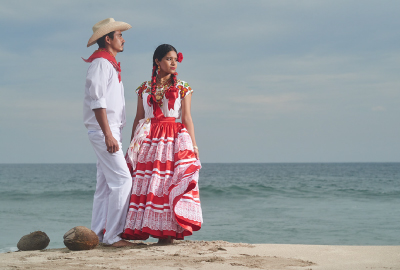
The typical female costume is made up of a wide skirt decorated with lace and ribbons and a white blouse with figures and beaded decorations on the neck. A scarf can also be used at the waist or in the hand. The outfit is completed with large earrings, necklace, bracelets and black high heels.
The typical costume for men is pants and a long-sleeved white shirt, plus a palm hat. The gentlemen carry 2 paliacates (a kind of handkerchief), one tied around their necks and the other in one hand. The footwear is black.
Typical costume of the Triqui people
The Triquis are an indigenous ethnic group that lives in the northwest of the state of Oaxaca, forming a cultural enclave in the middle of a vast Mixtec territory. Its main artisan symbol are long huipiles woven by the women with striking designs in which red predominates.
The huipil has drawings on the chest and back areas and may be crossed by ribbons of intense colors that contrast with the red of the piece. Triqui girls are trained by their mothers so that they learn from an early age to make their own huipiles.
The typical male clothing is black pants, a white shirt and a red poncho decorated similarly to the woman’s huipil. The shoes are made of cloth, although they can go barefoot. Other craft activities of the Triquis are pottery and the making of hats, mats and tents.
Typical costume of the “Oaxacan Chinas”
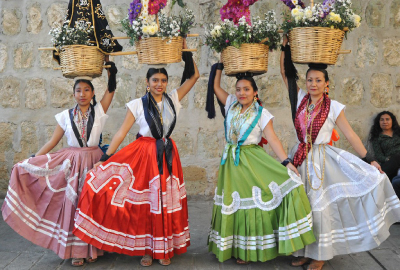
Although they are not as famous as the poblanas, the Oaxacan Chinas constitute a similar tradition and wear a beautiful typical costume that they wear at fiestas in honor of the Virgen de la Soledad and on other special occasions.
The Oaxacan Chinas come from the Barrio de China, a sector that according to one version is not called that way because of the women in typical dress, but because there were ceramic workshops that adorned their glazed products with little monkeys with slanted eyes.
The clothing is made up of a blouse with a series of embroideries, fabrics, fraying and other ornament details laboriously made by hand. The skirt is brightly colored with symbols from cultural miscegenation and images of fretwork that represent the art of pre-Hispanic peoples.
The Oaxacan Chinas also carry a flowery basket that they fill with food and other gifts.
Typical costume of Ejutla de Crespo
The Oaxacan municipality of Ejutla de Crespo and the Heroic City of Ejutla de Crespo, its head, are located in the Central Valleys Region, 66 km south of the state capital. Her typical female costume is made up of a brightly colored cotton skirt and a blouse of the same fiber with embroidery on the chest.
Women’s clothing may also include a shawl, which is usually black. The traditional footwear are huaraches.
The men wear a satin shirt with brocades in bright colors and carry a wool serape. They also wear a black hat of the so-called “donkey belly” adorned with a peacock feather. They wear houndstooth sandals.
More Tourist Attractions in OAXACA
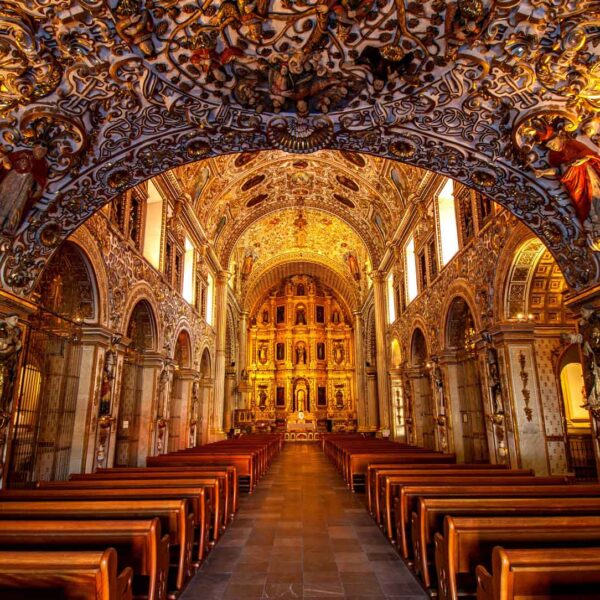
Santo Domingo Cultural Center
The Santo Domingo Cultural Center is a cultural complex that is located in what was one of the most important convents in the colony. It is a large convent in which the Museum of the Cultures of Oaxaca, the Fray Francisco de Burgoa Library and the Ethnobotanical Garden have been established. The Néstor Sánchez Public Newspaper Library is located in a building that is part of the complex but dates from the 19th century.… Read More
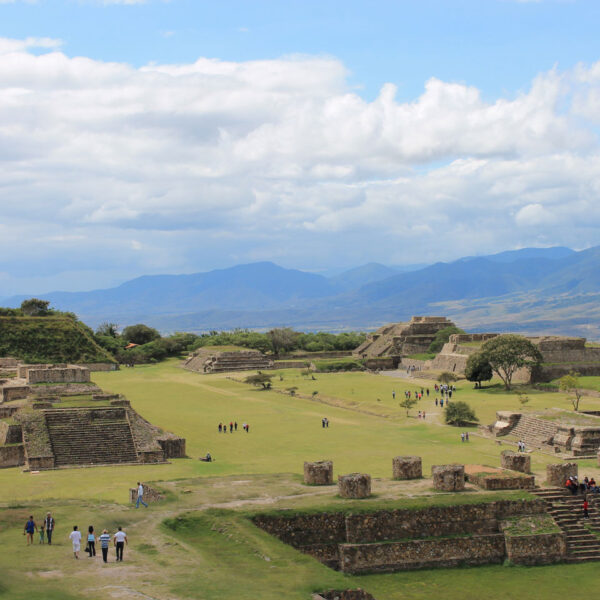
Monte Alban
Monte Alban is the most important archaeological zone of the Oaxacan entity, of unique regional importance due to the religious, political and economic control that the Zapotec state exercised over the population of the Valley of Oaxaca for more than thirteen centuries. It has been named by UNESCO Cultural Heritage of Humanity together with the city of Oaxaca on December 11, 1987. The heritage of the Zapotec world reaches us through the magnificent archaeological sites designed in the Valley of Oaxaca. Of these, the city of Monte Albán stands out for its enormous importance as an economic, political and religious hub (it was the first urban complex in Mesoamerica); by its extension, almost as big as the current capital of Oaxaca; and for its long life, started around 500 BC and concluded around 850 AD.… Read More
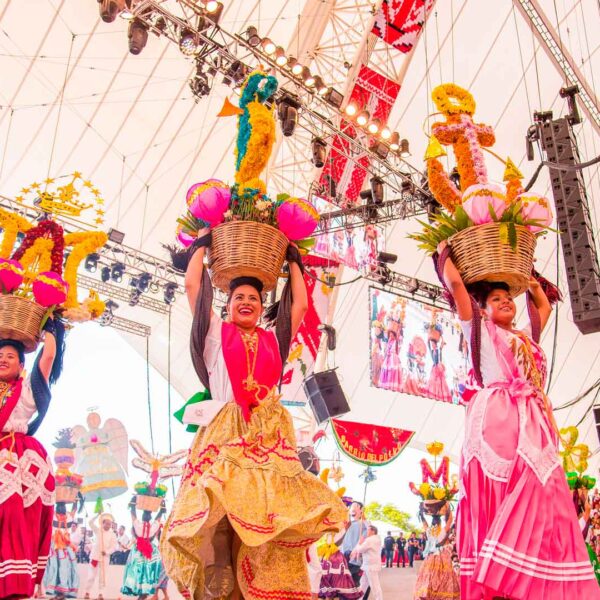
La Guelaguetza
The Guelaguetza is an ancient tradition with pre-Hispanic roots related to agricultural ceremonies of gratitude to the gods for the arrival of the rains and the lifting of the harvest at the end of July and is the largest festival in Oaxaca. La Guelaguetza is a celebration of gratitude for the arrival of the rains and the harvests, in which representatives from all regions of the state gather in the capital to share their culture through dances, crafts and food. La Guelaguetza is celebrated every year on the two Mondays after July 16, except when the first Monday is July 18, Benito Juárez’s death anniversary. Many types of dances also participate, such as the traditional Flor de Piña; where women usually dress in Huipiles representing the different regions of the state, as well as with their pineapple on their shoulders, they comb their hair with beautiful long braids accompanied by their ribbons and can not missing her accessories that is, bracelets, necklaces and earrings of precious colors and her beautiful makeup.… Read More

Mezcal
Mezcal is a rich, handcrafted flavored drink that requires considerable attention to be produced. Mezcal is normally served with white salt or worm salt (salt mixed with a cooked larva and ground chili), lemon or orange. Mezcal production today remains more or less as it was when the Spanish arrived hundreds of years ago. Each “recipe” is transmitted from generation to generation within the families that care about its production; Because each family has its own approach to mezcal production, there are an enormous number of different flavors. It is also in this way that the rich diversity of flavors and traditions are preserved for all to enjoy.… Read More
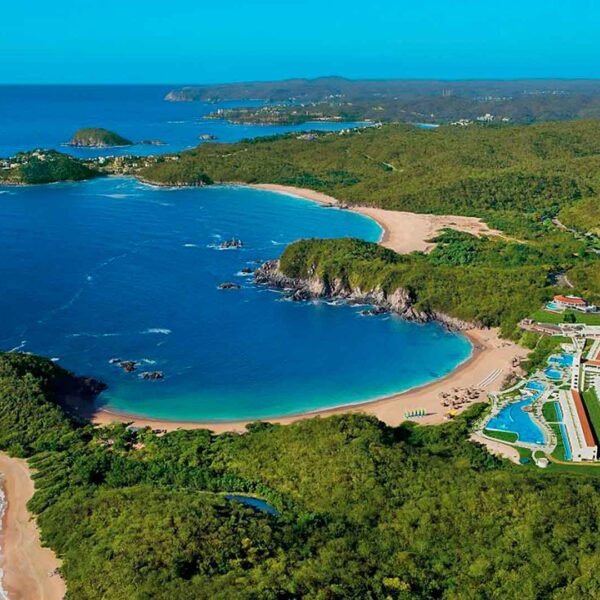
Beaches in Oaxaca
The beaches of the coast of the state of Oaxaca are among the most beautiful and complete in Mexico, thanks to a developing tourist infrastructure and the rich gastronomy of the Pacific. Along the 533 kilometers of coastline, the beaches of Oaxaca offer a wide variety of activities for lovers of water sports: snorkeling, diving, sport fishing, surfing, among others… there is something for everyone!… Read More
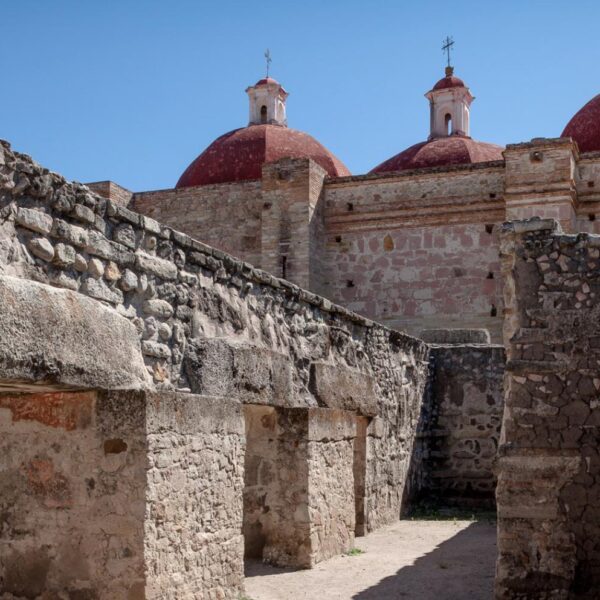
Archaeological Sites in Oaxaca
Oaxaca is famous throughout the world for its archaeological sites and the history they keep. Discover Monte Alban, Mitla, Yagul and more of these remote sites, which have made Oaxaca a World Heritage city, according to Unesco. The original Zapotec and Mixtec peoples of Oaxaca lived in the cities and religious centers of the valley of this city until the time of Spanish colonization. Today, there are still vestiges of these towns and places where you can meet them.… Read More
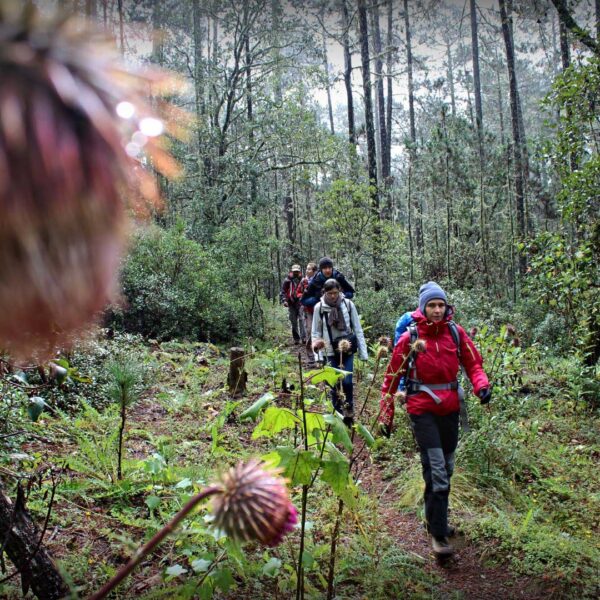
Ecotourism and Adventure in Oaxaca
Oaxaca, located in the southeast of Mexico, is an example of a singular miscegenation that even in the midst of modernity never forgets its origins. In its varied geography, it brings together not only a vast biodiversity, considered among the largest in the world, but also insurmountable cultural and ethnic riches, and the most different and beautiful natural settings. An ideal space for Alternative Tourism, Oaxaca offers activities such as walking, mountain biking, rappelling, climbing, zip-lining, horseback riding, observation of flora and fauna and more, in close contact with nature. The visitor can also witness the various aspects of local life, savor the gastronomy and enjoy the warmth of its people, as well as an offer of accommodation in hotels, ecotourism cabins, local houses or excellent camping areas.… Read More
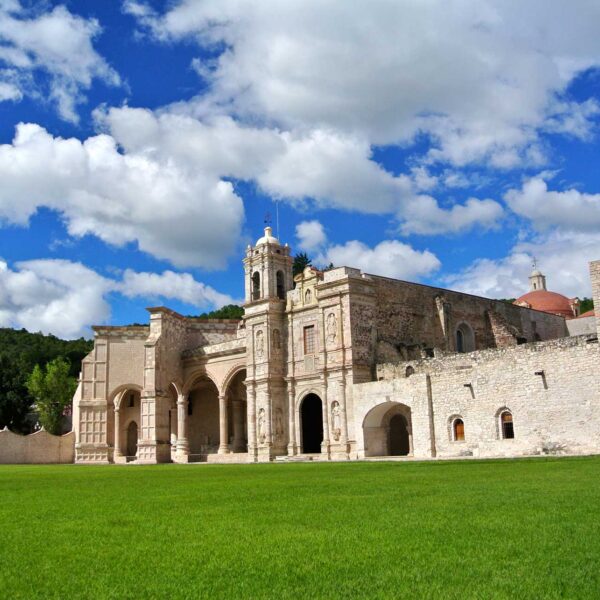
Magical Towns in Oaxaca
In Oaxaca we are proud to have 5 communities that have been awarded the title of Magical Towns of Mexico, a Magical Town is a town that has symbolic attributes, legends, history, transcendent events, everyday life, in short magic that they emanate in each of their socio-cultural manifestations, and that today mean a great opportunity for tourist use. The Magic Towns Program contributes to revalue a group of populations in the country that have always been in the collective imagination of the nation as a whole and that represent fresh and different alternatives for national and foreign visitors.… Read More
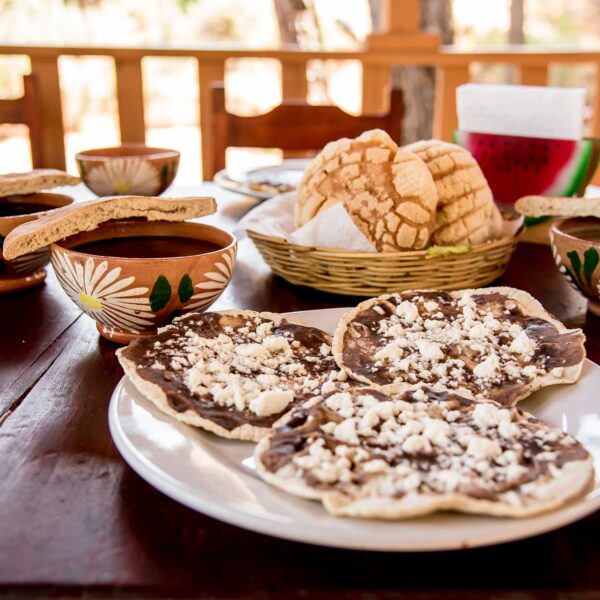
Gastronomy of Oaxaca
The Oaxacan gastronomy takes you on an amazing journey into one of the most outstanding and colorful cuisines in the world. Oaxacan food is among the most varied and delicious in Mexico, UNESCO has declared it Humanity’s Cultural Patrimony. Oaxaca’s gastronomy incorporates elements of pre-Hispanic cuisine, and lively imagination has created combinations that amaze by the color, the aromas and the flavors.
The list of dishes that characterize this cuisine is endless, however, we can mention: Oaxacan Mole in its 7 varieties depending on the type of chili used, Chapulines, (dry roasted, spiced grasshoppers), tlayudas (large tortilla spread with the remaining of the lard and beans), maguey worm sauce, chiles rellenos (stuffed chilies), and of course the famous Oaxacan tamales in banana leaves. Oaxaca cheese is a soft white string cheese, which is similar to mozzarella. It is sold in “ropes” which are wound onto themselves into balls, and eaten cold or lightly melted on quesadillas is considered among the best in the world.… Read More
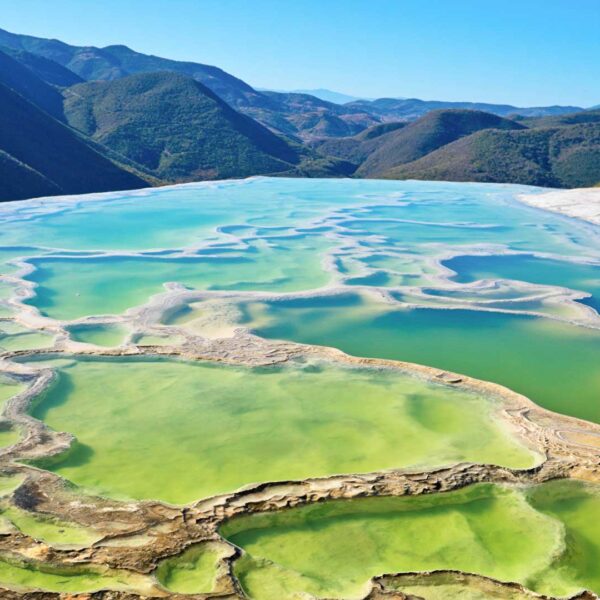
Oaxaca City Surroundings
Oaxaca is a destination that offers a great variety of attractions and tourist charms which leave anyone surprised. When arriving in the city of Oaxaca, the most common is to visit the historic center, the Santo Domingo Temple, the Macedonio Tourist Walk, the gastronomic delights in the Benito Juárez market, the Basilica de la Soledad, among other attractions. And one of the places that you cannot miss is the Monte Alban archaeological zone, which is approximately 30 minutes by car from the historic center. However, there are other places that are also worth knowing and are in the surroundings of the city. For this reason we recommend the following tourist routes.… Read More
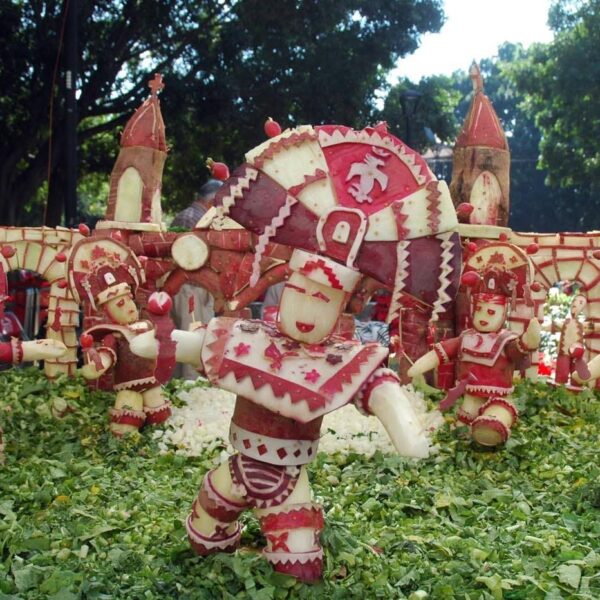
Traditions of Oaxaca
In the state of Oaxaca there are many customs and traditions throughout the year, and within the state, said that they have the same purpose of celebration but with different things, in fact from one region to another or even more from one town to another, the Customs vary for perhaps details but that is what makes them authentic. All the holidays are celebrated, the profane and the religious ones. The festival calendar is extensive due to the diversity of ethnic groups, which they still conserve. Oaxaca has a combination in its traditions of the culture of the ancestors and the current culture, a state that does not lose its customs, adapts them to new times and needs.… Read More
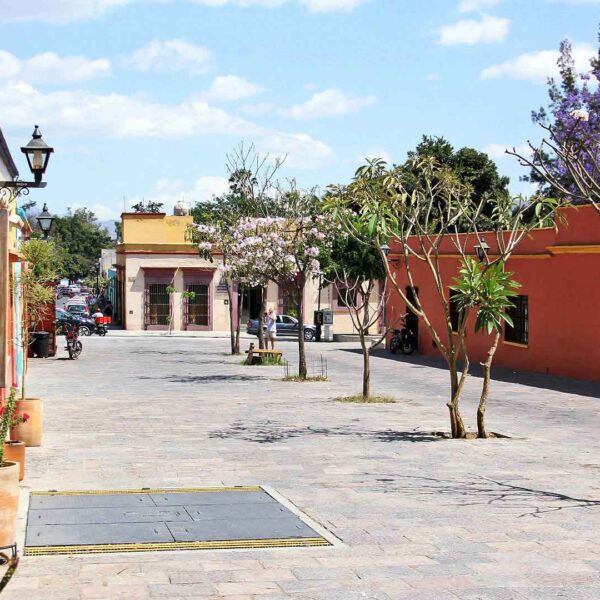
Oaxaca City
Oaxaca is the most diverse state in Mexico. It has peaks that reach more than 3,000 meters high, caverns that are among the deepest in the world, virgin beaches, secluded forests, and sunlit valleys. Oaxaca is rich in traditions and customs and has the largest ethnic population found in Mexico.
The City of Oaxaca, the state capital, is famous for its architecture and for its rich cultural traditions. Oaxaca is also graced by a splendid and varied cuisine and spring-like weather year round. UNESCO declared the city a Cultural Heritage Site.… Read More
Guided Tours in OAXACA
Flights & Hotels in OAXACA
More Tourist Attractions in MEXICO

Capital Cities
Folklore, gastronomy, literary culture, art and exhibitions, is what you will find in the capitals of the states of Mexico. To the north, colonial Mexico, Puebla, Guadalajara, Guanajuato, the Sonoran desert and the California peninsula. To the east Veracruz and the gulf. To the west Acapulco, Oaxaca and Tuxtla Gutiérrez. And to the south the Riviera Maya and the pyramids of Chichén-Itzá, Tulúm and Cobá in Yucatán, Palenque in Chiapas, the cenotes, and the Central American jungles.… Read More

Beaches
On the Beaches of Mexico you can immerse yourself in the intense blue ocean of the Pacific bays, sunbathe on the shore of the warm and transparent waves of the Caribbean Sea in Quintana Roo or even rest on the beautiful coasts of the Gulf of Mexico. Mexican beaches hide wonderful secrets for the traveler. By visiting them, in addition to enjoying the excellent climate and water activities, you can discover splendid archaeological sites and interesting colonial cities without traveling long distances.… Read More

Ecotourism and Adventure
Mexico is one of the best countries for Ecotourism as it has a great variety of flora and fauna, as well as a large number of refuges for extraordinary species. You can enjoy recreational activities of appreciation and knowledge of nature through contact with it, such as: stargazing, observation of natural attractions, wildlife and bird watching. Throughout México there are more than 176 protected natural areas, 5 of them considered by UNESCO as Natural Heritage of Humanity. Just for this and much more, we believe that Mexico is a Paradise for Ecotourism.… Read More

Magical Towns
A Magical Town is a place with symbols and legends, towns with history that in many cases have been the scene of transcendent events for our country, they are places that show the national identity in each of its corners, with a magic that emanates from its attractions ; visiting them is an opportunity to discover the charm of Mexico. The Magical Towns Program contributes to revalue a set of populations in the country that have always been in the collective imagination of the nation and that represent fresh and varied alternatives for national and foreign visitors. A town that through time and in the face of modernity, has conserved, valued and defended its historical, cultural and natural heritage; and manifests it in various expressions through its tangible and intangible heritage. A Magical Town is a town that has unique, symbolic attributes, authentic stories, transcendent events, everyday life, which means a great opportunity for tourist use, taking into account the motivations and needs of travelers.… Read More

States Of Mexico
Mexico has an incredible diversity of landscapes, where the beauty of its beaches, internationally recognized, stands out. In its vast territory of coasts, there are beaches of unparalleled beauty, and colorful landscapes. A large network of first-class hotels and tourist services is available to visitors to these beaches. Mexico is also mystical places, dotted with archaeological testimonies inherited from its original inhabitants. Monuments made by the Mayas, Aztecs and Toltecs are located in magical landscapes, like lighthouses in an ocean of natural beauty. They offer visitors buildings that tell their history, and museums that collect their cultural heritage. And that keep alive ancestral traditions, in ceremonies and festivals, where you can enjoy cultural activities and entertainment.… Read More

Traditions in Mexico
It is practically impossible to make a meticulous, and above all, accurate selection of the places to visit in Mexico. Each place that our country houses is unique and beautiful in its own way. Mexico, with its nearly 2 million km², has a large number of scenarios to offer, as well as endless activities to do. Do not lose your way and enter the places to visit in Mexico. In Mexico, apart from the beaches and its famous archaeological sites, there are many other really interesting sites and activities that you should know. In the surroundings of the main cities you will find places full of culture and tradition, where you can spend relaxing, interesting and fun vacations. On your trip through Mexico you cannot stop obtaining souvenirs, the crafts that are made here are of the highest quality and recognized worldwide. A shopping tour cannot be missed.… Read More

Archaeological Sites
The Archaeological Zones are the cultural past of every Mexican. You will be amazed at the ambient, nature and the environment that surrounds them. Climbing to the top or being around it will take us back in time to admire every detail. México is a country of culture and traditions, many of which we have inherited from the pre-Hispanic inhabitants of this vast territory, although it is true that there were more settlements in the central and southern part of the country, it is also possible to find some archaeological remains in the north.
… Read More

Gastronomy
The Gastronomy of Mexico has a great diversity of typical dishes, which is why it was recognized by UNESCO as Intangible Heritage of Humanity. The basic and representative ingredients of Mexican dishes are: corn, coriander, chili, beans, piloncillo, nopal and tomato. Mexican cuisine is also characterized by its sauces, which serve as an accompaniment to traditional dishes, prepared based on spices.… Read More

